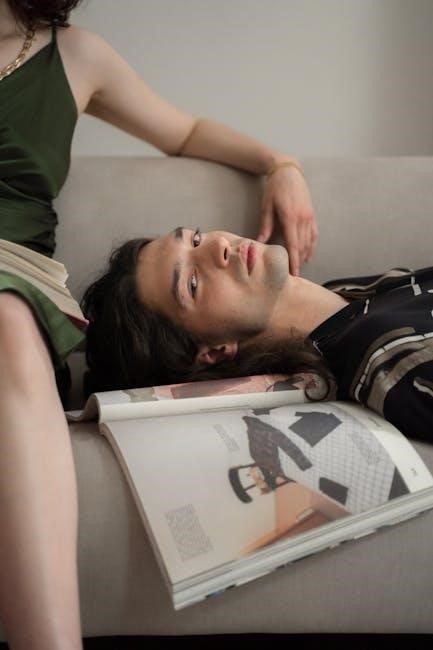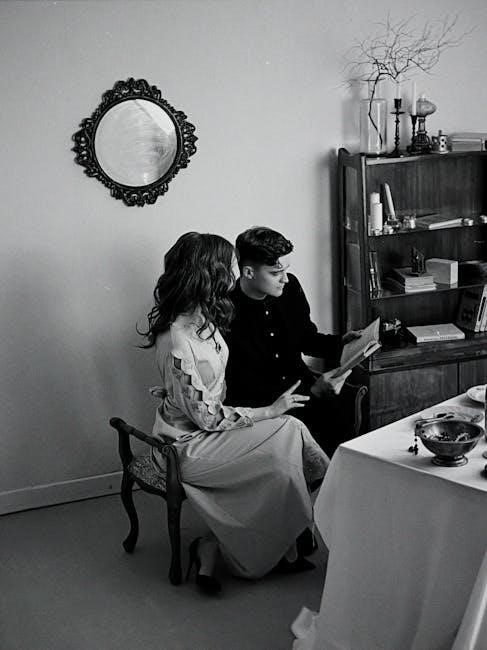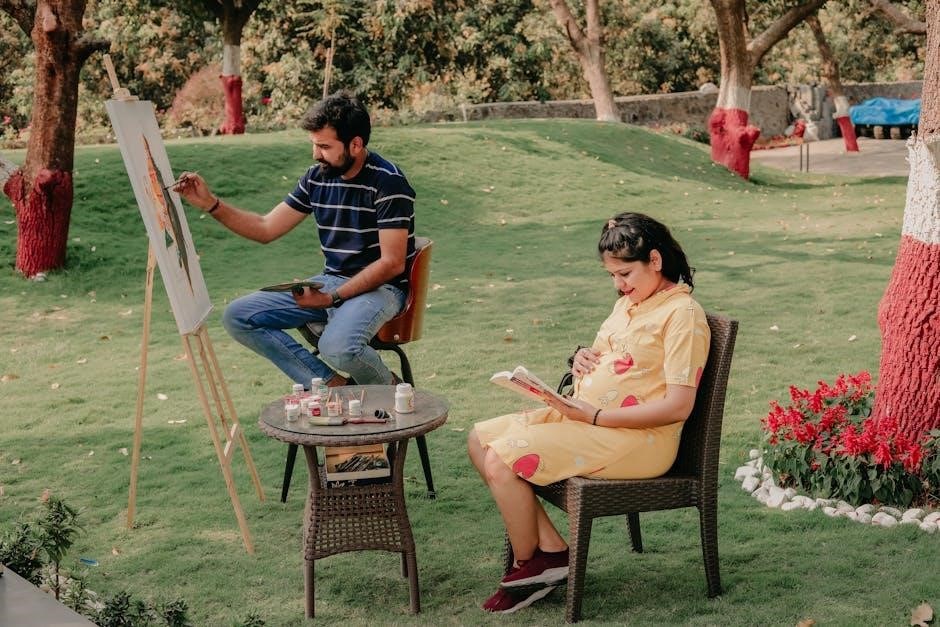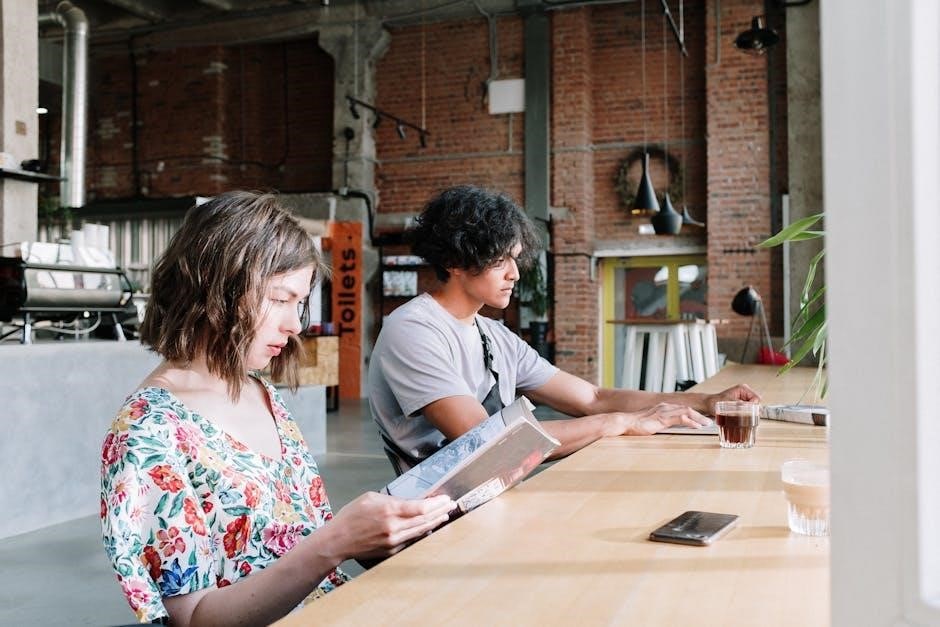The book explores the gender gap in the art world‚ examining historical and contemporary disparities between male and female artists in sales‚ representation‚ and recognition‚ inspiring change.
1.1 Overview of the Book’s Purpose
This book examines the gender gap in the art world‚ challenging existing narratives and promoting equality. It explores historical and contemporary disparities‚ offering insights through case studies and data. The purpose is to highlight the contributions of female artists‚ address systemic biases‚ and encourage a critical reevaluation of gender roles in art‚ fostering a more inclusive understanding of artistic achievement.
Historical Contributions of Female Artists
Female artists have long struggled for recognition‚ yet their resilience and innovation have redefined artistic expression‚ challenging societal norms and enriching cultural narratives throughout history.
2.1 The Struggles of Female Artists in a Male-Dominated Art World
Female artists have historically faced systemic discrimination‚ limited opportunities‚ and gender bias‚ often overshadowing their contributions. Despite their talent‚ they encountered exclusion from art academies‚ galleries‚ and exhibitions‚ perpetuating their underrepresentation. The art market’s gender disparities‚ as evidenced by auction data‚ highlight the undervaluing of their work. Artists like Renate Bertlmann and Katy Hessel have challenged these norms‚ inspiring change and recognition for women in art.
2.2 Forgotten Female Artists and Their Hidden Contributions
Historically‚ female artists have been marginalized and undervalued‚ with their work often excluded from major collections and exhibitions. Despite their talent‚ many faced societal barriers‚ limiting their opportunities for recognition. Their contributions were frequently overlooked‚ yet they played pivotal roles in shaping art history. Recent efforts‚ such as Katy Hessel’s work‚ have shed light on these forgotten artists‚ highlighting their significance and challenging the male-dominated narrative of art.

The Gender Gap in Art Sales and Auctions
Studies reveal a significant disparity in art sales‚ with female artists’ works selling for 42% less than male artists’‚ reflecting systemic gender bias in the art market.
3.1 Price Disparities Between Male and Female Artists
Research indicates a stark disparity in art prices‚ with female artists’ works selling for 42% less than comparable pieces by male artists. Auction data highlights this gap‚ showing women’s art is consistently undervalued. This reflects systemic gender bias‚ as male artists dominate high-value sales. The market’s preference for male creativity perpetuates inequality‚ underscoring the need for transparency and equitable practices in art valuation and sales.
3.2 Auction Data: A Study of Gender-Based Revenue Differences
Auction data reveals significant revenue disparities‚ with female artists earning 42% less than their male counterparts for similar works. A study analyzing 1.9 million transactions from 1970 to 2016 confirmed this gap. Such findings underscore systemic undervaluation of women’s art‚ reflecting broader market biases. These disparities persist despite increasing recognition of female artists‚ highlighting the need for equitable valuation practices in the art market;
Representation of Female Artists in Museums and Galleries
Female artists are underrepresented in museums and galleries‚ with only 25% of works in the National Gallery of Australia by women‚ reflecting systemic gender inequality in art institutions.
4.1 Current Statistics on Gender Representation in Art Institutions
Statistics reveal a significant gender gap in art institutions‚ with only 25% of works in the National Gallery of Australia by female artists. Similar disparities exist globally‚ reflecting systemic inequality; Museums often underrepresent women‚ with male artists dominating collections and exhibitions. Income disparities also persist‚ with female artists earning 30% less than their male counterparts. Auction data further highlights this imbalance‚ as works by women sell for 42% less on average. Curators play a crucial role in addressing these gaps‚ yet their selections often perpetuate existing biases. Efforts to increase representation are growing‚ but progress remains slow. The art world must actively work to challenge and change these statistics to achieve greater gender equality.
4.2 The Role of Curators in Promoting Female Artists
Curators play a pivotal role in addressing gender inequality in art by actively promoting female artists. They can challenge biases by selecting diverse exhibitions and acquisitions. Conscious curation helps shift narratives‚ ensuring women’s contributions are highlighted. Collaborating with organizations advocating for gender equality further amplifies their impact. By prioritizing inclusivity‚ curators can help bridge the gender gap in art institutions and foster a more equitable art world.
The Role of Feminist Movements in Promoting Female Artists
Feminist movements have championed female artists by challenging stereotypes and advocating for equal representation. Initiatives like exhibitions‚ publications‚ and educational programs have amplified their visibility and contributions to art history.
5.1 The Impact of Feminist Art Movements on Gender Equality
Feminist art movements have played a pivotal role in challenging gender biases and empowering female artists. By exposing systemic inequalities and celebrating women’s contributions‚ these movements have reshaped perceptions of art and identity. They have also inspired initiatives that promote inclusivity and representation‚ ensuring that female artists gain the recognition they deserve in a historically male-dominated field.
5.2 Landmark Books and Publications Highlighting Female Artists
Katy Hessel’s The Story of Art Without Men and Linda Nochlin’s essays are landmark works challenging male-dominated narratives in art history. These publications highlight overlooked female artists‚ offering fresh perspectives on gender equality in the art world. They inspire dialogue and advocate for greater representation‚ ensuring women’s contributions are acknowledged and celebrated in the historical and contemporary art landscape.

Economic Factors Affecting Male and Female Artists
Significant income disparities exist between male and female artists‚ with auction prices and market trends reflecting systemic gender biases in the art industry.
6.1 Income Disparities Between Male and Female Artists
Female artists consistently earn less than their male counterparts‚ with studies indicating a 30% income gap. Affluent collectors often undervalue women’s work‚ exacerbating price disparities. Auction data reveals paintings by women sell for 42% less than similar works by men‚ reflecting systemic gender bias in the art market.
6.2 The Influence of Art Market Trends on Gender Bias
Art market trends significantly influence gender bias‚ as collector preferences and auction dynamics often undervalue female artists. Studies reveal that paintings by women sell for 42% less than similar works by men. Market trends perpetuate these disparities‚ with affluent male collectors frequently rating women’s art lower. However‚ growing awareness and advocacy are gradually shifting perceptions‚ encouraging greater recognition of female artists’ contributions and challenging systemic inequities.
The Influence of Art Critics and Collectors
Art critics and collectors significantly shape the art world’s gender dynamics‚ with critics often favoring male artists and collectors undervaluing female artists‚ perpetuating systemic inequality.
7.1 How Art Critics Shape Perceptions of Male and Female Artists
Art critics play a pivotal role in shaping perceptions‚ often favoring male artists‚ as studies reveal gender-biased language in reviews. Male artists are frequently praised for innovation‚ while female artists are overlooked or undervalued. This disparity reinforces stereotypes‚ limiting opportunities for women. Critics’ opinions influence market trends‚ exhibitions‚ and public perception‚ perpetuating inequality in the art world‚ as highlighted by gender-based revenue differences in auction data and underrepresentation in museums.
7.2 The Role of Collectors in Promoting Gender Equality
Collectors play a crucial role in advancing gender equality by actively acquiring and promoting works by female artists. Their purchasing decisions influence market trends and artist visibility‚ helping to bridge the gender gap in art sales. By prioritizing female artists‚ collectors challenge historical biases and create opportunities for underrepresented voices‚ fostering a more inclusive art world and driving systemic change in representation and valuation.
Case Studies: Female Artists Who Broke Barriers
Female artists like Renate Bertlmann and Katy Hessel have challenged societal norms‚ transforming art’s narrative and paving the way for future generations of women in the arts.
8.1 Renate Bertlmann and Her Exploration of Sexuality
Renate Bertlmann‚ an Austrian artist‚ began exploring sexuality and gender roles in the 1970s‚ challenging societal norms through her work. By embracing both female and male identities‚ she delved into the social constructs of sexuality‚ creating impactful art that questioned traditional norms. Her bold approach not only broke barriers but also inspired future generations to re-examine gender and identity‚ leaving a lasting legacy in the art world.
8.2 The Story of Art Without Men: Katy Hessel’s Contribution
Katy Hessel’s groundbreaking book‚ The Story of Art Without Men‚ challenges the male-dominated narrative of art history by highlighting female artists’ contributions. Inspired by E.H. Gombrich’s The Story of Art‚ which excluded women‚ Hessel’s work retells art history through a female lens. Her book‚ named Waterstones Book of the Year‚ sheds light on overlooked artists and addresses the gender imbalance in art collections‚ inspiring a more inclusive understanding of artistic heritage.
Case Studies: Male Artists and Their Market Dominance
Male artists historically dominate the art market‚ with their works fetching higher prices at auctions and commanding greater representation in galleries and collections globally.
9.1 The Market Value of Male Artists vs. Female Artists
male artists consistently dominate the market‚ with their works fetching significantly higher prices. Studies reveal female artists’ paintings sell for 42% less than similar works by males. This disparity reflects systemic gender bias‚ as women’s contributions are historically undervalued. Auction data shows a stark gap‚ with male artists commanding premium prices‚ while female artists struggle for equal recognition and fair market value.
9.2 The Role of Male Artists in Shaping Art History
Male artists have traditionally dominated art history‚ shaping its narrative through iconic movements like the Renaissance‚ Impressionism‚ and Cubism. Their works often set benchmarks for artistic excellence‚ influencing generations. Notable figures such as Picasso‚ Michelangelo‚ and Van Gogh have defined cultural and aesthetic standards. Their prominence in historical records and exhibitions underscores their role in forming the canon‚ often overshadowing female contributions and narrowing the scope of artistic recognition.

The Role of Intersectionality in Art Opportunities
Intersectionality reveals how race‚ sexuality‚ and class compound gender-based challenges‚ limiting opportunities for artists. These factors often result in systemic exclusion and reduced visibility in the art world.
10.1 How Race‚ Sexuality‚ and Class Affect Opportunities for Artists
Race‚ sexuality‚ and class significantly influence artists’ opportunities. Marginalized groups face systemic barriers‚ including limited access to resources‚ biased representation‚ and stereotyping. Women of color‚ LGBTQ+ artists‚ and those from lower socioeconomic backgrounds often encounter compounded discrimination‚ affecting their visibility and success in the art market. These intersecting factors perpetuate inequality‚ highlighting the need for inclusive policies and support systems to ensure equitable opportunities. The art world must address these disparities to foster true diversity and representation‚ enabling all artists to thrive regardless of their background or identity‚ and challenging the status quo that has historically excluded diverse voices from mainstream recognition and economic success.
10.2 The Intersection of Gender and Artistic Expression
Gender profoundly shapes artistic expression‚ with women often exploring themes tied to identity‚ inequality‚ and personal experience. Historical exclusion from mainstream art narratives has led female artists to challenge stereotypes and redefine creativity. Their work frequently addresses societal expectations and gendered roles‚ fostering a unique perspective that enriches the cultural landscape. This intersection highlights the importance of gender equity in shaping diverse and inclusive artistic voices.

Modern Initiatives to Promote Gender Equality
Modern initiatives include organizations supporting female artists‚ educational programs‚ and social media campaigns promoting gender equality in the art world‚ fostering equal representation and opportunities.
11.1 Programs and Organizations Supporting Female Artists
Initiatives like the #FemaleArtists movement and organizations such as The National Museum of Women in the Arts provide crucial support through grants‚ mentorship‚ and exhibitions. These programs aim to elevate female artists’ visibility and challenge gender disparities. By fostering inclusive environments‚ they encourage diverse representation in galleries and museums. Such efforts highlight the importance of equitable opportunities‚ helping to bridge the gap in the art world.
11.2 The Role of Social Media in Promoting Gender Equality in Art
Social media platforms have emerged as powerful tools for promoting gender equality in art. They provide female artists with global visibility‚ bypassing traditional gatekeepers. Movements like #WomenInArt and #FemaleArtists have gained momentum‚ fostering a sense of community and amplifying underrepresented voices. These digital spaces democratize art‚ enabling direct engagement between artists and audiences‚ thereby challenging historical inequities and reshaping the art world’s dynamics.
Advancements in gender equality in art are evident‚ yet challenges persist. Education‚ advocacy‚ and inclusive practices are crucial to ensure equal opportunities and recognition for all artists.
12.1 The Ongoing Fight for Gender Equality in the Art World
Gender inequality persists in the art world‚ with female artists facing lower valuations‚ limited representation‚ and income disparities. Despite progress‚ systemic barriers remain‚ emphasizing the need for continued advocacy‚ education‚ and policy changes to ensure equal opportunities and recognition for all artists‚ fostering a more inclusive and equitable art industry.
12.2 The Importance of Education and Awareness
Educating audiences about the historical exclusion of female artists and their contributions is crucial for fostering equality. Books like The Story of Art Without Men by Katy Hessel challenge male-dominated narratives‚ revealing overlooked talents. Raising awareness through education empowers future generations to recognize and value diverse artistic voices‚ promoting a more inclusive art world and inspiring change.

References and Further Reading
Key sources include studies on auction prices‚ gender representation‚ and feminist art movements. Books like The Story of Art Without Men offer deeper insights into female artists’ contributions.
13.1 Key Sources and Recommended Literature
Key sources include The Story of Art Without Men by Katy Hessel‚ Linda Nochlin’s essays on gender in art‚ and studies on auction price disparities. Recommended literature explores feminist art movements‚ historical contributions of female artists‚ and intersectionality in art opportunities. These works provide comprehensive insights into the challenges and triumphs of female artists‚ offering a rich foundation for understanding gender dynamics in the art world.
